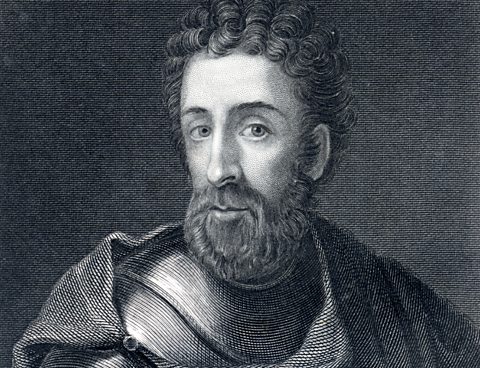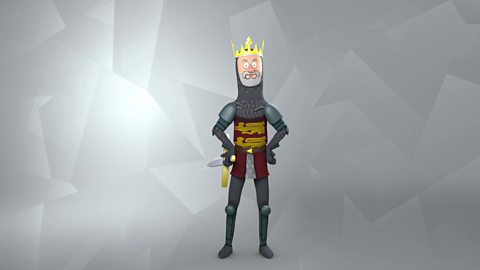Sir William Wallace was a Scottish knight and an important leader during the Scottish Wars of Independence.
Find out more about one of the most famous Scots in history: William Wallace.
NARRATOR:
The Wars of Independence. William Wallace. 1270 – 1305
Who’ll remember you in 700 years’ time? And for what?
For keepy-uppies? For the High Score? For the world’s longest bogie?!
We don’t know much about the early years of William Wallace. There’s a story that he killed the English Sheriff of Lanark.
No-one knows for sure if this is true but we do know that ~ When Edward the First, King of England, invaded Scotland way back in 1296, it looked like nobody would ever challenge the might of the English army.
Scotland’s Castles were occupied by English soldiers and English Sheriffs enforced the law. But some Scots, including Wallace, fought back. Wallace was hunted by the English as an Outlaw – a criminal.
And in September 1297, Wallace joined forces with Andrew Murray, another great fighter from the North of Scotland.
Together they took on a much larger English Army and beat them at the Battle of Stirling Bridge. It was the first time in medieval times that soldiers on foot had beaten men on horses.
It was a great and surprising victory for Scotland but the English King must have been furious! Afterwards, Wallace and Murray were made joint Guardians of Scotland. Sadly Murray died later, leaving only Wallace to protect Scotland.
Seven months after the Battle of Stirling Bridge, in April 1298, King Edward invaded Scotland at the head of a large army. This time, the English King crushed Wallace’s Army outside Falkirk and Wallace was lucky to escape with his life.
Wallace, defeated, resigned from being Guardian. He was on the run once again, a wanted man, hunted by Edward’s soldiers.
But he didn’t give up. Hiding in the forests, he never stopped fighting: hiding, attacking, escaping for another seven years ~
Until Wallace was eventually captured in 1305 and executed in London. The crime was disobeying the King: Treason!
Wallace isn’t remembered because of who he was, but for what he did. We think of him as acting not just for himself. But for Scotland. Standing up for what he believed in, no matter what the cost.
That’s why people still remember him to this day. What will you be remembered for?

Who was William Wallace?
In 1296 John Balliol surrendered to Edward I of England and was removed as King of Scots. Edward took control of Scotland, He forced 2, 000 Scottish nobles to swear they would be loyal to him. Some Scots refused to see Edward as their king and fought back.
One of those people was a man called William Wallace.
We don't know much about Wallace's early life but in 1297, he is reported to have killed William de Heselrig, the English High Sheriff of Lanark.
Instead of going into hiding, Wallace continued his rebellion. He attacked other Scottish places controlled by Edward.

How did Wallace fight back?
Wallace is famous for two battles. In the first, Wallace and his co-commander, Andrew Murray, defeated a large English army at the Battle of Stirling Bridge in 1297.
After this, Wallace was made a Guardian of Scotland - a man who would defend the nation.
The next battle didn't go so well. At the Battle of Falkirk in 1298, Wallace was defeated when Edward I took personal control of the battle.
Wallace facts
- Wallace was born around 1270
- He might have been born at Elderslie near Paisley or Ellerslie in Ayrshire
- He was executed in London in 1305 by being hung, drawn (cut open) and quartered (his body was cut into four parts)
- After his death, his head was dipped in tar and put on a spike on London Bridge!
- The four parts of his body were sent to Berwick, Newcastle, Stirling and Perth
- His ancestors may have been Welsh as the name 'Wallace' is from the Old English word for Welshman

What happened to William Wallace?
After the Battle of Falkirk, Wallace resigned as Guardian on Scotland and went on the run.
Seven years later, Wallace was captured near Glasgow. He was sent to London where he was tried for treason (disobeying the English King) and hanged, drawn, and quartered in 1305.
Wallace is still remembered to this day for standing up for what he believed in.

More on Wars of Independence
Find out more by working through a topic
- count5 of 13

- count6 of 13

- count7 of 13

- count8 of 13
